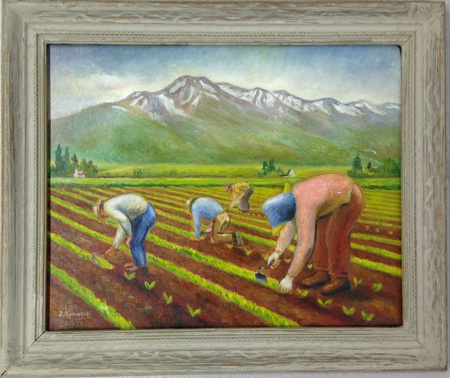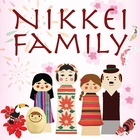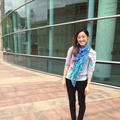Jack Yamasaki, my father’s uncle, is someone I only have the faintest memories of seeing on occasion and visiting during holidays. I always knew he was an artist though, because I’ve been surrounded by his artwork my entire life—drawings and paintings by “Uncle Jack” have always hung on the walls of my parents’ and grandmother’s homes. Looking back, his artwork was probably my earliest exposure to art as a child.
A few decades later, I find myself fortunate enough to have studied art and to have worked in museums. I’ve had the opportunity to see some incredible artwork in the various institutions in which I’ve worked, including the Japanese American National Museum, where I currently spend my days. Recently, I had the great privilege of bringing several members of my family to the museum, where staff in the Collections Management and Access (CMA) Unit were kind enough to bring out five works by Uncle Jack for us to look at.
Most of these were pieces that my family and I had never seen before. In some cases, they were gifted to the museum by donors who are not family members. And it was a little odd for me to see Jack Yamasaki’s name among the other great artists in JANM’s collection. Though always appreciated by my family, it wasn’t until recently that I gained respect for the broader significance of his artwork and the events documented in them.

This 1942 painting was really interesting for us to see. It is a depiction of life in the Heart Mountain concentration camp in Wyoming, where Jack spent the war years. Reminiscent of JANM’s recent Colors of Confinement display, this work depicts camp life in bright, vivid colors; a rare and striking thing when you’re used to looking at black-and-white photographs. We noticed that it is still in its original frame, made by Jack.

I was also attracted to this pencil and ink drawing. In a busy scene, again from Heart Mountain in 1942, men are laying bricks in winter. On the left, one figure tosses a brick to another, with the brick depicted in mid-air. The cloudy sky and the way the figures are bundled up and hunched over as they walk really conveys a sense of the cold climate.

This one is a definite favorite for more personal reasons. The figure in pink in the foreground is my grandmother, someone I spend a great deal of time with. At 99 years old, she is one of the most impressive people I know. She says this was painted when the family was farming in Utah after the war. The other figures in the painting are family friends from pre-war days in the Imperial Valley. Her account doesn’t quite match the official description on file at the museum. However, my grandma is pretty sharp and has a great memory, so I prefer her version of the story.
My family had seen a reproduction of this painting, but it wasn’t until the CMA Unit staff brought it out that we saw the original. We were all struck by how the colors were much brighter than we thought they were. It was the first time my grandma had seen it since Uncle Jack painted it so many years ago.
At first, seeing it again brought up an old annoyance. According to her, she had told Jack she wanted to buy the painting and he said she could. But after one of his exhibitions, she found out that he had sold it to someone else! I remarked that this painting’s journey brought it to JANM, where it is now professionally cared for in a controlled environment. It is probably better off than it would be at her house, and she agreed!
* This article was originally published on First & Central: The JANM Blog on June 11, 2015.
© 2015 Lynn Yamasaki






